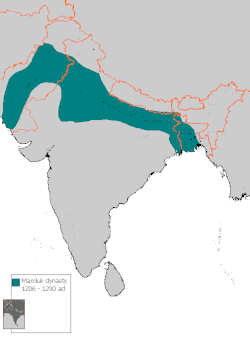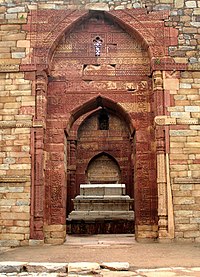Mamluk dynasty (Delhi)
This article needs additional citations for verification. (March 2012) |
Mamluk Sultanate | |||||||||||||||
|---|---|---|---|---|---|---|---|---|---|---|---|---|---|---|---|
| 1206–1290 | |||||||||||||||
 Mamluk Sultanate of Delhi | |||||||||||||||
| Capital | Delhi | ||||||||||||||
| Common languages | Persian and Turkic | ||||||||||||||
| Religion | Sunni Islam | ||||||||||||||
| Government | Sultanate | ||||||||||||||
| Sultan | |||||||||||||||
• 1206–1210 | Qutb-ud-din Aibak | ||||||||||||||
• 1286–1290 | Muiz ud din Qaiqabad | ||||||||||||||
| History | |||||||||||||||
• Established | 1206 | ||||||||||||||
• Disestablished | 1290 | ||||||||||||||
| |||||||||||||||
The Mamluk Dynasty (sometimes referred as Slave Dynasty or Ghulam Dynasty) (Urdu: سلسله غلامان, Hindi: ग़ुलाम ख़ानदान), was directed into India by Qutb-ud-din Aybak, a Turkic general of Central Asian birth. It was the first of five unrelated dynasties to rule India's Delhi Sultanate from 1206 to 1290.[1][2] Aybak's tenure as a Ghurid dynasty administrator ranged between 1192 to 1206, a period during which he led invasions into the Gangetic heartland of India and established control over some of the new areas.
History

Mamluk, literally owned, was a soldier of slave origin who had converted to Islam. The phenomenon started in 9th century AD and gradually the Mamluks became a powerful military caste in various Muslim societies. Mamluks held political and military power most notably in Egypt, but also in the Levant, Iraq, and India. In 1206, Muhammad of Ghor died. He had no child, so after his death, his sultanate was divided into many parts by his slaves (mamluk generals). Taj-ud-Din Yildoz became the ruler of Ghazni. Mohammad Bin Bakhtiyar Khilji got Bengal. Nasir-ud-Din Qabacha became the sultan of Multan. Qutub-ud-din-Aybak became the sultan of Delhi, and that was the beginning of the Slave dynasty.[3]
Aybak rose to power when a Ghorid superior was assassinated.[4] However, his reign as the Sultan of Delhi was short lived as he died in 1210 and his son Aram Shah rose to the throne, only to be assassinated by Iltutmish in 1211.
The Sultanate under Iltutmish established cordial diplomatic contact with the Abbasid Caliphate between 1228–29 and had managed to keep India unaffected by the invasions of Genghis Khan and his successors.[2] Following the death of Iltutmish in 1236 a series of weak rulers remained in power and a number of the noblemen gained autonomy over the provinces of the Sultanate. Power shifted hands from Rukn ud din Firuz to Razia Sultana until Ghiyas ud din Balban rose to the throne and successfully repelled both external and internal threats to the Sultanate.[2][4] The Khalji dynasty came into being when Jalal ud din Firuz Khilji overthrew the last of the Slave dynasty rulers, Muiz ud din Qaiqabad, the grandson of Balban, and assumed the throne at Delhi.[5]
Architecture

The architectural legacy of the dynasty includes the Qutb Minar, Mehrauli by Qutb-ud-din Aybak, Sultan Ghari near Vasant Kunj, the first Islamic Mausoleum (tomb) built in 1231 A.D. for Prince Nasir ud din Mahmud, eldest son of Iltumish, and Balban's tomb, also in Mehrauli Archaeological Park.
List of Mamluk Sultans
| Titular Name | Personal Name | Reign | Notes |
|---|---|---|---|
| Sultan سلطان |
Qutb-ud-din Aibak قطب الدین ایبک |
1206 – 1210 | Temporarily quelled the rebellions of Nasir-ud-Din Qabacha of Multan and Tajuddin Yildoz of Ghazni. He made Lahore his capital and consolidated his control over North India through administrative hold over Delhi. He also initiated the construction of Delhi's earliest Muslim monuments, the Quwwat-ul-Islam mosque and the Qutub Minar. Died accidentally in 1210 while he was playing a game of polo in Lahore on horseback: his horse fell and he was impaled on the pommel of his saddle. He was buried near the Anarkali bazaar in Lahore. |
| Sultan سلطان |
Aram Shah آرام شاہ |
1210 – 1211 | The rise of Chihalgani (The Forty); an elite group of 40 nobles. They conspired against Aram Shah and invited Shams-ud-din Iltutmish, then Governor of Badaun, to replace Aram. Iltutmish defeated Aram in the plain of Jud near Delhi in 1211. What became of Aram is not quite certain. |
| Nasir Amir-ul-Mu'minin ناصرامیر المؤمنین |
Shams-ud-din Iltutmish شمس الدین التتمش |
1211 – 1236 | He shifted Capital from Lahore to Delhi. He defeated Nasir-ud-Din Qabacha of Multan and Tajuddin Yildoz of Ghazni, who had declared themselves contenders of Delhi. Mongols invaded India in pursuit of Jalal-ud-din Mangabarni who was defeated at the Battle of Indus by Genghis Khan in 1221. After Genghis Khan's death Iltutmish consolidated his hold on northern India by retaking many of the lost territories. He built the Hauz-i-Shamsi reservoir in Mehrauli in 1230. In 1231, he built Sultan Ghari, the first Islamic Mausoleum in Delhi. |
| Sultan سلطان |
Rukn-ud-din Feroze رکن الدین فیروز |
April 1236 – November 1236 | Ruled for just seven months. His mother Shah Turkan for all practical purposes was running the government. He abandoned himself to the pursuit of personal pleasure and debauchery, to the considerable outrage of the citizenry. On November 9, 1236, both Rukn-ud-din Feroze and his mother Shah Turkan were assassinated by the Chihalgani . |
| Jalâlat-ud-dîn Raziyâ Sultana جلالۃ الدین رضیہ سلطانہ |
Razia al-Din رضیہ الدین |
1236 – 1240 | First Female Muslim Ruler in India. Initially she managed to impress the nobles and she administratively handled the Sultanate well before associating with the African Jamal-ud-Din Yaqut provoking racial antagonism amongst the nobles and clergy, who were primarily Turkish and already resented the rule of a female monarch. She was defeated by the powerful nobleman Malik Altunia whom she agreed to marry. However, her brother Muiz-ud-din Bahram usurped the throne with the help of the Chihalgani and defeated the combined forces of the Sultana and her husband. Both fled and reached Kaithal, where their remaining forces abandoned them. They both fell into the hands of Jats and were robbed and killed on October 14, 1240. |
| Sultan سلطان |
Muiz-ud-din Bahram معز الدین بہرام |
1240 - May 15, 1242 | During his reign the Chihalgani became disorderly and constantly bickered among each other. It was during this period of unrest that the Mongols invaded the Punjab & sacked Lahore. The sultan was too weak to take any step against them. The Chihalgani besieged him in the White Fort of Delhi and put him to death in 1242. |
| Sultan سلطان |
Ala-ud-din Masud علاءالدین مسعود |
1242 - 1246 | He was more of a puppet for the Chihalgani (the forty chiefs) and did not actually have much power or influence in the government. Instead, he became infamous for his fondness of entertainment and wine. By 1246, the chiefs became upset with Sultan's increasing hunger for more power, and replaced him with Nasir-ud-din Mahmud, another son of Iltutmish. |
| Nasir-ud-din Feroze Shah نصیر الدین فیروز شاہ |
Nasir-ud-din Mahmud نصیر الدین محمود |
1246 – 1266 | As a ruler, Mahmud was known to be very religious, spending most of his time in prayer and renowned for aiding the poor and the distressed. However, it was actually his Deputy Sultan, Ghiyath-ud-din Balban, who primarily dealt with the state affairs. |
| Sultan سلطان |
Ghiyath-ud-din Balban غیاث الدین بلبن |
1266 – 1286 | Balban ruled with an iron fist. He broke up the Chihalgani group of nobleman. He tried to establish peace and order in India. He built many outposts in areas where there had been disorder and garrisoned them with soldiers. Balban wanted to make sure everyone was loyal to the crown, so he established an efficient espionage system. |
| Sultan سلطان |
Muiz-ud-din Muhammad Qaiqabad معز الدین قیق آباد |
1286 – 1290 | Being still young at the time, he ignored all state affairs. After four years, he suffered from a paralytic stroke and was later on murdered in 1290 by a Khilji chief. His three year old son, Kayumars (1290), nominally succeeded him. But the Slave dynasty had ended with the rise of the Khiljis |
See also
Notes
References
- Anzalone, Christopher (2008). "Delhi Sultanate". In Ackermann, M. E. etc (ed.). Encyclopedia of World History. Vol. 2. Facts on File. pp. 100–101. ISBN 978-0-8160-6386-4.
- Walsh, J. E. (2006). A Brief History of India. Facts on File. ISBN 0-8160-5658-7.
- Dynastic Chart The Imperial Gazetteer of India, v. 2, p. 368.
Further reading
- Srivastava, A. L. (1967). The History of India, 1000-1707 A.D.,. Shiva Lal Agarwala.
